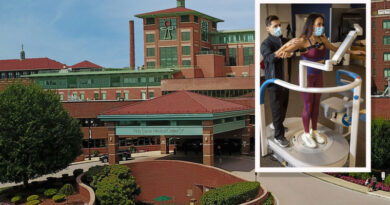A New Way to Prevent Blood Clots
A minimally invasive procedure reduces the risk of stroke for people with AFib.
The Watchman is a self-expanding device that closes the heart’s left atrial appendage, blocking clots from escaping.

Inside the heart lies a little-known structure called the left atrial appendage (LAA), a pouch in one of the heart’s chambers. It’s unclear what function, if any, the LAA performs in a normally functioning heart. “The LAA is similar to the appendix,” explains John Shao, MD, an interventional cardiologist at Newark Beth Israel Medical Center (NBI) and a member of RWJBarnabas Health Medical Group. “It’s important as the body develops, but once you’re born, you can do without the LLA.”
The LAA can cause problems, however, if a person has atrial fibrillation (AFib), an abnormal heart rhythm that increases the risk of developing a blood clot or having a stroke. Potentially life-threatening blood thickening is especially likely to occur in the LAA, which is filled with tiny pockets where blood cells can easily stick together.
Now, NBI has the capability to seal off the LAA and eliminate its clot risks with a minimally invasive treatment that deploys a device called the Watchman FLX. “This treatment has emerged as a key therapy to treat stroke risk from AFib over the past few years,” Dr. Shao says. “RWJBarnabas Health hospitals offering specialized care have implanted more than 500 Watchman devices. We’re very experienced in its use.”
ALTERNATIVE TO BLOOD THINNERS
In a procedure that takes an hour or less, an interventional cardiologist threads a catheter from the groin to the heart’s left atrium. There, it delivers the Watchman device under ultrasound guidance. The device, collapsed while inside the catheter, opens like an umbrella when it reaches the LAA. Eventually, heart tissue grows over the permanently implanted fabric-capped nickel titanium device and keeps clots in the LAA from entering the bloodstream. Most people go home the day after implantation.
Not everyone with AFib needs a Watchman implant. “Most patients take blood thinners to reduce the risk of blood clots, blockages and stroke,” Dr. Shao says. “But a range of problems can occur with blood thinners in the long term, such as bleeding, anemia and bruising. Also, we often prefer avoiding blood thinners in patients with other medical conditions that put them at risk of fainting or falling.”
Many patients receiving the Watchman can go off blood thinners and instead take less potentially problematic medications, such as aspirin. The Watchman’s relative safety has been well established in studies, Dr. Shao says. “It causes no change in heart pumping function or movement of blood through the heart’s chambers,” he says. “There’s little downside.”
Until this minimally invasive system became available, sealing the LAA might have been done as part of open-heart surgery, Dr. Shao says. “The Watchman is one more way Newark Beth Israel Medical Center is offering patients the most sophisticated cardiac technology and procedures in our community,” he says. “We’ve got everything you need right here.”
Whoever your heart beats for, our hearts beat for you. To connect with a top cardiovascular specialist at NBI, call 888-724-7123 or visit rwjbh.org/heart



